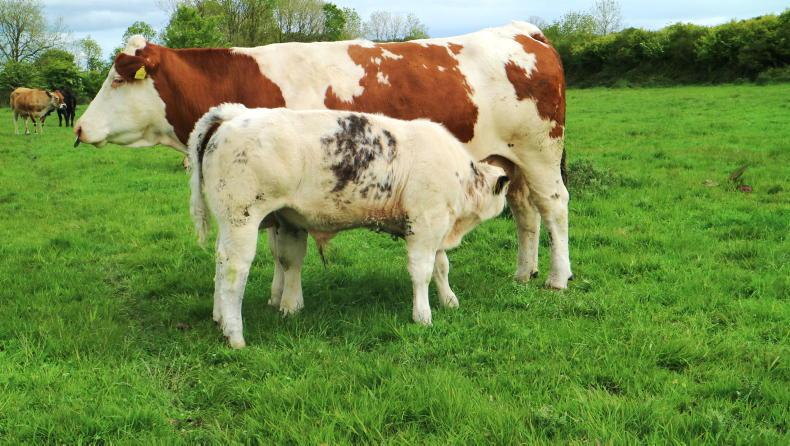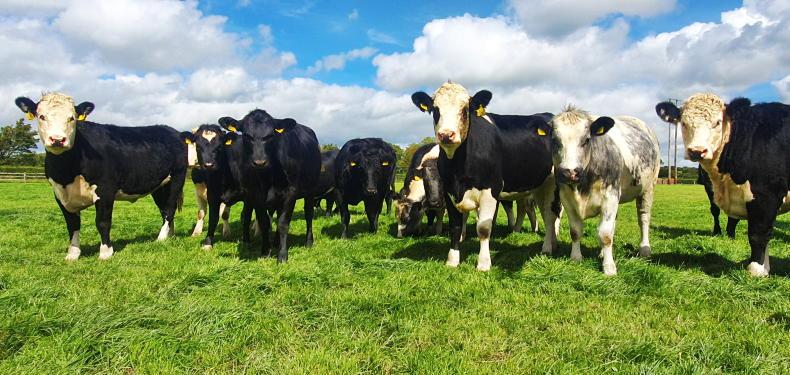In at 10cm and out at 4cm has always been the grazing advice for livestock in Ireland, however these recommendations were established primarily for dairy systems and subsequently adopted by the beef side of the house.
However, the key driver on most dairy farms is output per hectare, whereas, on most beef farms, where stocking rates are much lower, the performance of the individual animal is often more important that output per hectare.
Grange research
Over the years, Teagasc Grange has carried out a number of trials looking at both pre- and post-grazing sward heights for beef cattle.
In the first experiment, two groups of beef-cross dairy animals were grazed for an entire grazing season (mid-March to mid-October) to either a 3.5cm or a 5.0cm post-grazing sward height. As may have been expected, the animals grazing to 3.5cm were lighter to the tune of 30kg compared to their 5cm compatriots at the end of the grazing season.

Research on suckler cows showed that grazing to 5.5cm instead of 4cm meant cows were in better condition at housing and calves were up to 10kg heavier.
A second experiment was carried out looking at either 4cm or 5.5cm post-grazing sward heights on suckler cows and calves over an entire grazing season. At housing time, cow body condition was lower and calf liveweight was 8kg to 10kg lower for the group that grazed to the lower sward height.
Recent study
A more recent study looked at comparing post-grazing sward heights of 4cm and 6cm for spring-born, suckler-bred yearling bullocks over an entire grazing season and followed them through to beef out of the shed the following spring.
The experiment saw bullocks at grass for a 200-day grazing season receiving no supplementary concentrate. Following housing in early November they received a diet of grass silage only plus minerals and vitamins and were slaughtered out of the shed at 24 months old.
At the end of the grazing season the group that grazed to 6cm post-grazing sward height were 29kg heavier than the 4cm post-grazing sward height group. Following this through to slaughter it meant the heavier group at housing had a 15kg heavier carcase weight, meaning they held the advantage they had at housing.
Herbage digestibility measurements carried out throughout the grazing season reported no difference in the overall diet digestibility offered to stock and so it is assumed that the difference in liveweight was due to higher herbage intake. Put simply, asking stock to graze to 4cm will restrict their intake somewhat which had a negative effect on performance.

Trials with dairy beef stock saw housing weights 30kg lower for animals that grazed to 3.5cm compared to 5cm sward heights.
It is worth noting that had they been meal fed during the finishing period indoors, it would have lifted the energy density of the diet and there may have been a compensatory effect from the lighter group in this case.
In this study the pre-grazing sward height was the same for both groups. Grazing to 6cm versus 4cm resulted in a 15% reduction in the stock carrying capacity and the ground yielded 0.5tDM/ha less grass than that grazed to 4cm. Interestingly, there was no difference in the overall liveweight gain per hectare.
To reach the same carcase weight, the animals that grazed to 4cm would have needed another month in the finishing shed. This would incur further feed costs during an expensive feed period indoors and would have a negative impact on the overall carbon footprint of the system.
Next week we take a look at what the research says about pre-grazing sward heights for beef production systems in Ireland.
In at 10cm and out at 4cm has always been the grazing advice for livestock in Ireland, however these recommendations were established primarily for dairy systems and subsequently adopted by the beef side of the house.
However, the key driver on most dairy farms is output per hectare, whereas, on most beef farms, where stocking rates are much lower, the performance of the individual animal is often more important that output per hectare.
Grange research
Over the years, Teagasc Grange has carried out a number of trials looking at both pre- and post-grazing sward heights for beef cattle.
In the first experiment, two groups of beef-cross dairy animals were grazed for an entire grazing season (mid-March to mid-October) to either a 3.5cm or a 5.0cm post-grazing sward height. As may have been expected, the animals grazing to 3.5cm were lighter to the tune of 30kg compared to their 5cm compatriots at the end of the grazing season.

Research on suckler cows showed that grazing to 5.5cm instead of 4cm meant cows were in better condition at housing and calves were up to 10kg heavier.
A second experiment was carried out looking at either 4cm or 5.5cm post-grazing sward heights on suckler cows and calves over an entire grazing season. At housing time, cow body condition was lower and calf liveweight was 8kg to 10kg lower for the group that grazed to the lower sward height.
Recent study
A more recent study looked at comparing post-grazing sward heights of 4cm and 6cm for spring-born, suckler-bred yearling bullocks over an entire grazing season and followed them through to beef out of the shed the following spring.
The experiment saw bullocks at grass for a 200-day grazing season receiving no supplementary concentrate. Following housing in early November they received a diet of grass silage only plus minerals and vitamins and were slaughtered out of the shed at 24 months old.
At the end of the grazing season the group that grazed to 6cm post-grazing sward height were 29kg heavier than the 4cm post-grazing sward height group. Following this through to slaughter it meant the heavier group at housing had a 15kg heavier carcase weight, meaning they held the advantage they had at housing.
Herbage digestibility measurements carried out throughout the grazing season reported no difference in the overall diet digestibility offered to stock and so it is assumed that the difference in liveweight was due to higher herbage intake. Put simply, asking stock to graze to 4cm will restrict their intake somewhat which had a negative effect on performance.

Trials with dairy beef stock saw housing weights 30kg lower for animals that grazed to 3.5cm compared to 5cm sward heights.
It is worth noting that had they been meal fed during the finishing period indoors, it would have lifted the energy density of the diet and there may have been a compensatory effect from the lighter group in this case.
In this study the pre-grazing sward height was the same for both groups. Grazing to 6cm versus 4cm resulted in a 15% reduction in the stock carrying capacity and the ground yielded 0.5tDM/ha less grass than that grazed to 4cm. Interestingly, there was no difference in the overall liveweight gain per hectare.
To reach the same carcase weight, the animals that grazed to 4cm would have needed another month in the finishing shed. This would incur further feed costs during an expensive feed period indoors and would have a negative impact on the overall carbon footprint of the system.
Next week we take a look at what the research says about pre-grazing sward heights for beef production systems in Ireland.








 This is a subscriber-only article
This is a subscriber-only article











SHARING OPTIONS: